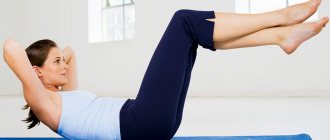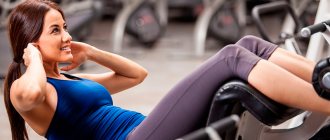Not all sports training is difficult and takes a lot of time and effort. Light training is also beneficial; it is suitable for warming up and morning exercises. You can do exercises lying down right on the bed, this will help you wake up faster and start the day with positivity and vigor. Here you will find three sets of exercises for performing while lying on your back and stomach; they are designed to be performed alternately, but can be used separately. Doing all of them together will take no more than ten minutes.
The first and second complexes are designed to be performed slowly, they will help wake up and prepare the body for more active movements from the third complex or another workout, for example, a morning run. The third complex is done at a fast pace; it tones the muscles and warms up the whole body. Do each exercise five or more times, and drink a glass of water after doing it.
Part 1. Under the blanket
Exercise No. 1
Stretch well, massage your earlobes, then rub your palms and rub the bridge of your nose until you feel a pleasant warmth. This will help you wake up and prepare for more active exercise.
Exercise No. 2 “Wave”
Body position - lying on your back, knees bent at right angles, right hand on your stomach, left hand on your chest. Take a deep breath, fill your lungs as much as possible with air, hold in this position for a few seconds, then exhale deeply so that your stomach inflates. Repeat 5-6 times.
For what:
trains the abdominal muscles, is good for the lungs, improves blood circulation.
Exercise No. 3 “Butterfly”
Starting position: lying on your back, arms along your body.
Bend your knees and turn them so that your feet are together and your knees are spread apart. Make movements with your legs, imitating the flapping of a butterfly's wings, try to reach your knees to the bed.
For what:
trains leg muscles, develops flexibility.
Exercise No. 4 “String”
Body position - lying on your back, legs straight, arms along the body.
Place your hands behind your head and stretch your fingers up and your toes down. Try to achieve maximum body tension, similar to a stretched string, and stay in this position for a few seconds. Repeat 3-4 times.
For what:
trains all the main muscles, tones them.
Exercise No. 5 “Stretching”
Stay in the same position - lying on your back, arms along your body.
Flat stomach: exercises, how to pump up your abs correctly?
When we want to lose weight, certain areas of the body face particular difficulties. The stomach can be considered one of these zones: it is not easy to reduce it, but it can grow in just a few days - for example, after holidays, vacations or holidays.
On the subject: How to pump up the heart muscle
Many women think that everything can be easily corrected by doing abdominal exercises, and they allow themselves to calmly gorge themselves on cakes and other sweets, hoping that they can quickly get into shape by properly “pumping up” their muscles.
Muscles, including those in the abdomen, are indeed strengthened by intense exercise, but the layer of fat may not go away unless you reduce the number of calories in the diet, so you need to act in all directions - a one-sided approach will bring little benefit.
But how to properly perform abdominal exercises to get the maximum effect? Provided that you have already balanced your diet, many more factors influence the effectiveness of exercise, and the main one can be called regularity: if you cannot exercise every day, do it every other day - you should do it at least 4 times a week, and preferably 2 once a day - morning and evening.
The room where you practice must be ventilated, and it is good if the temperature in it is not higher than 18°C. Of course, the stomach should not be full: in the morning you should generally train on an empty stomach, and in the evening - 2-2.5 hours after eating, and after training, try not to eat for at least 1.5 hours.
The exercises should be performed on the floor, on a fairly hard mat, and not on a sofa or mattress, as some do, although this option can also be used - in addition to the main training. If you feel thirsty while doing exercises, you can take 1-2 sips of mineral water (still) - to do this, place the bottle close to you.
You need to do the exercises quite intensively - only then will the excess fat go away for sure.
It may be difficult at first, so it’s better to start with 2-3 sets of 10-15 times, but you must do the exercises correctly so that certain muscles are tensed.
Gradually the number of repetitions should be increased, but the number of approaches should remain unchanged; exercises are performed without jerking, smoothly and calmly. It is important to breathe correctly: when lifting your body, inhale, and when lowering onto the mat, exhale.
If you have problems with the spine, you cannot pump your abs: your back should not hurt - if there is pain, you need to consult a specialist and solve this problem.
- You need to start with stretching. Lying on the mat with your knees bent, place your hands behind your head and gently stretch the muscles for several minutes.
- Then, leaving your hands behind your head and your legs bent, place your feet together and begin to lift your torso to your knees, lifting both shoulder blades off the floor - you don’t need to lift your lower back off the floor.
- The next exercise is done in the same position, but you need to spread your knees a little, and alternately stretch your elbows to your knees - to the left and right.
- Then the legs are placed at the width of the feet, the arms are placed along the body, and the body is raised completely, and the arms are extended forward.
- Lying on your back, arms to the sides, palms pressed to the floor. The half-bent legs are raised at a right angle and tilted alternately left and right, trying to touch the floor with them. When bending your legs, you need to inhale, lifting them back - exhale.
- Lying on the mat with your knees bent and your arms stretched out along your torso, you must first lift your pelvis up without lifting your lower back from the floor, and then vice versa - lift your lower back without lifting your shoulders and pelvis from the floor.
- In the same position, lying on the mat, with your hands clasped behind your head, your legs bent at the knees, you need to lift them simultaneously with your upper body, and reach your elbows towards your knees.
A couple more exercises that everyone knows: cycling and push-ups. The bicycle just needs to be performed correctly, tensing the abdominal muscles; push-ups are a difficult exercise for many girls and women - it requires effort, but it also brings double benefits: if you learn how to do push-ups correctly, not only your stomach will become beautiful - your chest will also tighten and take on a good shape.
These exercises are among the simplest, but if you wish, you can choose many of them, taking into account your characteristics, since all people are different.
And now about exercises that can be done in bed: after all, many of us find it very difficult to wake up and get up in the morning, and exercise right in bed does not deprive us of comfort, but helps us get ready.
Important!
Having woken up, you must first stretch properly, stretching your arms behind your head and completely straightening your toes: you need to tense several times and then relax.
Breathing exercise: take a deep breath, tighten your abdominal muscles, hold your breath for 5 seconds, and then relax. Try this as many times as you are; if it doesn’t work, do it halfway, and finish it during the day - you can do this exercise either sitting or standing.
Next, you will have to roll over and stand on your hands and knees, straightening your back and looking ahead. Take a deep breath, pull in your stomach, and at the same time arch your back up as far as you can - this is what a cat does when it sees a strange dog. Hold this for 8-10 seconds, exhale and relax - repeat 3 times.
The next exercise is well known: lie on your back again, palms under your head, elbows to the sides, legs bent at the knees. Raise your torso and reach with your right elbow towards your left knee - for starters, you can repeat 5-10 times, then do the same with your left elbow and right knee - this is how the oblique abdominal muscles are worked.
Lastly, rest is just as important as stretching. Lying on your back, bend your legs and cross them so that your left foot is under your right leg and your right foot is under your left. Place your hands along your body, palms up, and breathe calmly - lie there for at least a minute.
Then carefully straighten your legs, turn on your side—preferably on your right—and get out of bed.
If you manage to do a few more exercises during the day - in the first half of the day and towards the evening, after a while your stomach will begin to shrink, become elastic and neat.
Many girls are interested: is it possible to do abdominal exercises during menstrual periods? Some even claim that they exercise any day and do not feel any ailments, but it is still better to refrain from exercise, since the uterus enlarges during menstruation, and exercise makes it shrink. As a result, bleeding may increase, and menstruation may take longer, and your stomach will hurt. Experts recommend resuming training only 2 days after your period ends.
On the subject: How to pump up the groin muscles
When pumping up your abs, you shouldn’t be too zealous at all, and try to do the exercises for as long as possible. Overload does not strengthen the abdominal muscles, but tires them, and then they simply refuse to work, and the load is transferred to other muscle groups. It turns out that we seem to be working out, but we don’t get any noticeable results - so we shouldn’t force ourselves to “pump” to the point of exhaustion.
If you plan your day correctly, abdominal exercises will not take much time, and then you will get used to it and will do them just for fun.
Advice!
A positive result can only be obtained with regular exercise, but let’s remember once again about the diet.
You should eat as little food as possible containing simple carbohydrates: white bread, sweet buns and cookies, sugar, potatoes, white rice, canned food, chips, fast food products, etc.
The amount of fat, especially animal fat, should also be reduced to a minimum, and the amount of protein, on the contrary, increased: eat meat, fish, seafood, dairy products, cheese - protein products should be combined with green vegetables and unsweetened fruits.
In parallel with exercise and diet, it is worth using anti-cellulite creams: it is better to select them separately - for the hips, buttocks, abdomen and other problem areas of the body.
Source: https://xn—-htbbacbpccnglsso1ag.xn--p1ai/fitness/ploskij-zhivot.html
Part 2. Throw back the blanket
Exercise No. 6 “Cobra”
Lie on your stomach, rest on your hands and begin to slowly rise without lifting your pelvis from the bed. Then fix the position of the maximum deflection for a few seconds and return to the starting position.
For what:
trains the muscles of the neck, chest and abdomen, develops flexibility.
Exercise No. 7 “Drawing with your feet”
We return to the starting position - lying on your back, arms out to the sides.
Move your legs to a vertical position and begin writing different numbers and letters in the air. First left then right. Afterwards, to relieve tension, roll over onto your stomach and swing your legs a little in different directions.
For what:
trains the muscles of the legs and abdomen.
Exercise No. 8 “Rolls”
Starting position: lying on your back.
Bend your legs and pull them to your chest, clasp them with both hands. Then, in this position, begin to turn your body from side to side for 30-40 seconds.
For what:
trains the back muscles, relieves tension from the spine.
Exercise No. 9 “Boat”
Starting position: lying on your stomach, arms extended forward, legs straight.
Slowly lift your legs and arms off the bed and slightly raise your chest, hold in this position as long as you can, repeat several times.
For what:
trains: muscles of the back, legs and arms.
Exercise No. 10 “Basket”
We continue to lie on our stomach, legs bent at the knees.
We put our hands behind our backs and clasp our feet, try to stretch ourselves upward, bend in the lower back and raise our chest. The exercise should be performed slowly and gradually, bending at the lower back without any discomfort.
For what:
trains: back muscles, develops flexibility.
Part 3. Moving on to active exercises
Exercise No. 11 “Scissors”
Starting position: lying on your back, arms along your body, legs straight.
Raise your legs at an angle of about 45 degrees, place your hands under your buttocks, this will help relieve tension in your lower back. Then start swinging your legs. The left leg moves to the right, the right to the left, then vice versa, imitating the movement of scissors.
For what:
trains the abdominal and leg muscles.
Exercise No. 12 “Bicycle”
Starting position: lying on your back.
Raise your legs and bend your knees, then perform rotational movements, as if pedaling a bicycle. Try to make the range of motion wider to increase the load on the abdominal muscles.
For what:
trains the abdominal and leg muscles.
Exercise No. 13 “Side Swings”
Starting position: lying on your right side.
Place your right hand under your head or against the bed to stabilize the position. Next, we swing with our left leg, alternating the direction up and down and from side to side. We perform 5-10 swings on each side.
For what:
trains leg muscles, develops flexibility.
Exercise No. 14 “Swings on the back”
Starting position - lying on your back, legs straight, arms along the body.
We raise our right and left legs alternately and make swings.
For what:
trains the muscles of the legs and abdomen, develops flexibility.
Exercise No. 15 “Rise”
Starting position - lying on your back, legs straight, arms along the body.
Begin to slowly rise until your hands touch the tips of your feet. While performing this exercise, it is important to keep your legs firmly pressed to the bed and your knees not to bend.
For what:
trains: back and leg muscles, develops flexibility.
Exercise No. 16 “Half Bridge”
Starting position - lying on your back, legs bent at the knees, arms along the body.
Place your arms and legs on the bed and lift your pelvis as high as possible, then return to the starting position. Repeat the exercise 7-10 times.
For what:
trains the muscles of the buttocks and back of the legs.
Exercise No. 17 “Bends”
Starting position: sitting, legs bent at the knees.
Slowly lower your body, stretch your arms and stretch forward, try to stretch your back as much as possible. We stay in this position for 5-10 seconds, then return to the starting position.
For what:
trains the back muscles, relieves tension from the spine, and develops flexibility.
Exercise No. 18 “Tilting the head”
Starting position: sitting on the bed, legs in lotus position.
Place your hands behind your back and lean on them. Slowly press your chin to your chest, and then tilt your head back at the same pace. After this, gradually lower your head to your left shoulder, then return it to a straight position. Repeat the movement to the right shoulder. Repeat the exercise 5-6 times.
For what:
trains the neck muscles, relieves tension from the vertebrae in the cervical region.
Exercise No. 19 “Boxing”
Starting position - lying on your back, legs slightly bent at the knees, arms along the body.
What can you do right at work?
Diaphragmatic breathing
What it is useful for: to relax tense muscles and a tired nervous system.
How to do it: Place one hand on your chest and the other below your rib cage so you can feel your diaphragm move as you breathe.
Be aware of its expansion as you inhale in four counts. Hold for a second, then exhale in four counts.
Repeat the exercise five times and check your body from your heels to the top of your head. Feel where the tension remains.
Perhaps you are unconsciously pulling your head into your shoulders? If so, try to relax them purposefully.
"Office Cat-Cow"
The cat-cow exercise is a yoga asana and is usually performed on all fours. But nothing prevents you from modifying it to perform directly on your chair!
What it's good for: For upper and lower back mobility.
: without getting up from the chair, slowly push your life forward, creating a deflection in the lower back. Gradually, lift your chest one vertebra at a time, then gently tilt your head back and look at the ceiling.
Then begin to “twist” in the opposite direction - slowly lower your head and press your chin to your chest.
Start rounding (one vertebra at a time, remember?) the upper back, the middle, then the lower back. Finish by “pulling” the hips so that the tailbone also participates.
Repeat two to three times.
Butt stretch
The exercise is usually performed while standing, but is well adapted for sitting “working exercises”.
What it's good for: For mobility of the hips, buttocks and lower back.
How to do it: While sitting in a chair, cross your right ankle over your left thigh. Sit up straight and inhale. As you exhale, “stretch” your navel toward the seat.
Keeping your spine long, bend down as deeply as you can.
Hold the stretch for 30 seconds to 2 minutes, then switch legs.
Torso twists
What it is useful for: to relieve neck pain and ease breathing.
How to do it: Lean forward slightly while sitting in a chair and clasp your hands tightly in front of your chest.
Breathe in.
Exhale slowly, turning your neck and spine all the way to the right. When you reach your “rotation limit,” hold this position for a second.
Then, following your left ear, slowly turn your head over your left shoulder.
Gently return your head and chest to the starting “center” position and repeat the exercise, but this time turn to the left.
Perform rotations 2-3 times for each side.
"Open heart"
What it's good for: Chest, upper back and shoulder mobility.
How to do it: If you're sitting, grab the back of a chair. While standing—and if your range of motion allows it—clasp your fingers at the back of your spine.
Lift your chest toward the ceiling and lower your shoulders. While maintaining this position, breathe through your chest and stomach; 3-5 deep breaths will be enough.
Doorway Quadratus Psoas Stretch
What it is useful for: for mobility of the lower back and tendons
How to do it: Stand in the middle of a doorway and cross your left foot over your right. Reach your left arm up and forward to grab the doorframe while stretching your left hip.
Exhale to deepen the stretch and hold for 15-20 seconds. Be sure to repeat the exercise on the other side of the body.
The technique of performing the exercise is shown in detail at around 0.56
Fidgeting
What it's good for: for mobility of the whole body
How to do it: This exercise may seem a little childish to you, but it helps you realize how long we sit still.
While sitting in a chair, shift your weight from side to side. If you find yourself leaning on your right hip while working, switch to your left.
If you always place your left foot on top of your right, switch them. Rotate your neck, ankles, wrists, wiggle your toes.
Do as much as you like (and don't forget to have fun!).
Wrist rotation
What is it useful for: to improve the mobility of the wrist and forearm, to prevent carpal tunnel syndrome.
: Hold your right wrist with your left hand and slowly move it in circles. Make four full turns clockwise and four full turns counterclockwise. Switch hands and repeat.











